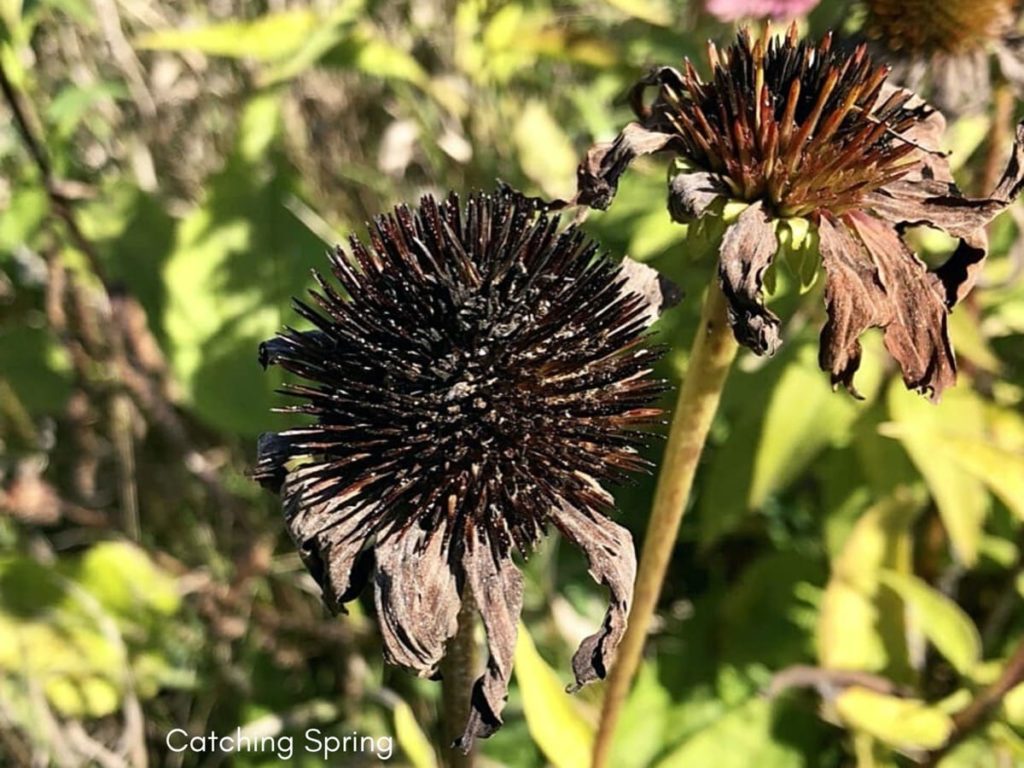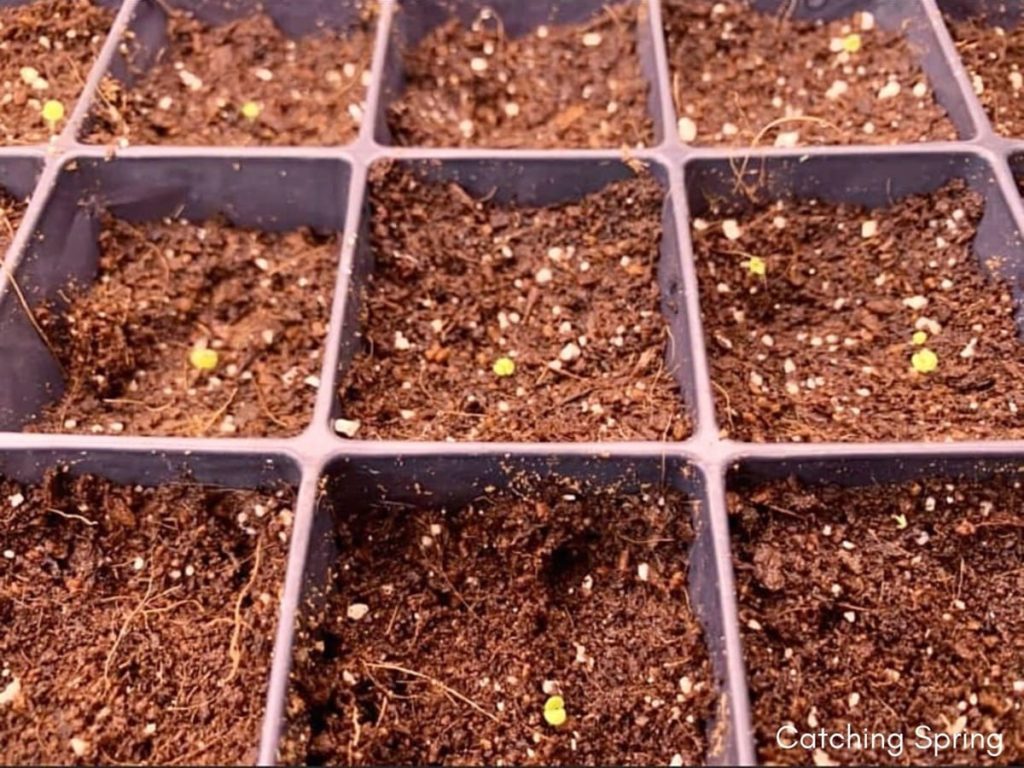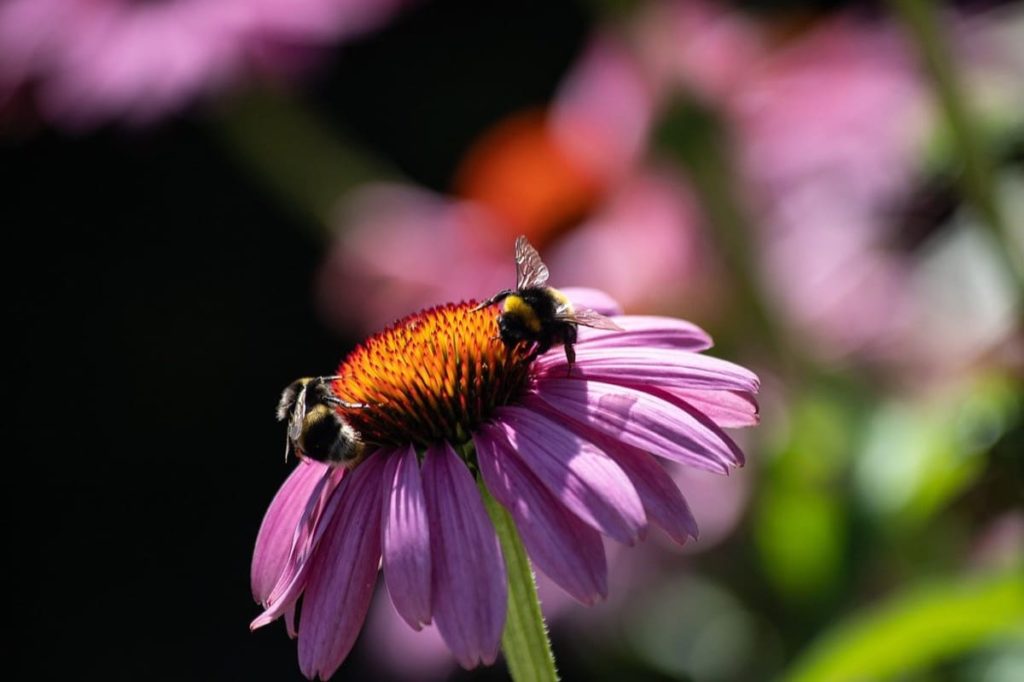Growing Echinacea, aka Coneflower from seed, starts with a dried flower, cold-stratification if you wish, stored in a cool, dark place, and sown in good soil when the time is right! Plants grow readily from seeds so let’s dive deeper now!
This post contains affiliate links. For more information, see our disclosures here.
Complete Guide to Growing Echinacea/Coneflower From Seeds
1. All about Echinacea

Most of us know the beautiful and beneficial plant as coneflowers. When we hear Echinacea, we often think of the herbal remedies this flower offers.
Echinacea (pronounced “eh-kuh-nei-shuh”) is a herbaceous flowering plant in the daisy family.
The genus Echinacea actually consists of 10 species, which we call coneflowers. And coneflowers aren’t just the color purple they are known for. They also come in orange, yellow, lilac, pale green, white, and ruby-purple colors.

In the garden
You’ll notice that coneflowers get a lot of attention in the garden; they are a pollinator favorite!
Butterflies, bees, and other beneficial insects will grab a meal from the flowers all day long. And after it goes to seed, you’ll see a vast amount of birds dining on them as well.

Thankfully one dried-up flowerhead contains a fair amount of seeds, so it’s very beneficial to NOT deadhead the flowers in the fall, but leave them all winter long.
Growing Echinacea benefits wildlife!
Herbal remedy
A quick note on the benefits of Echinacea for humans, while studies are still biased on the effects of using this flower as a remedy, some people swear by it.
It’s said to help alleviate headaches, cold and flu symptoms, and UTIs, along with some other things you wouldn’t want to treat at home anyway.
Some also boast that it boosts the immune system. Whatever you believe, if you want to use it as an herbal remedy, then why not grow it yourself?
Growing Echinacea is easy, and you can be sure of the product’s quality when it’s in your own garden. Including the fact that no pesticides were used on a plant you plan on ingesting!
2. When to collect seeds

There’s something about the end of summer/beginning of fall that makes me have an insatiable desire to collect seeds from flowers, trees, bushes, and plants everywhere! Haha!
That being said, it’s essential to exercise patience, or your seed collecting will come up empty.
Harvesting seeds too early will cause them to not be viable; they need to finish out on the plant!
Growing Echinacea from seeds is no different. You need to wait until the entire flowerhead is brown and dry. If you see some half-colored petals still on the flower, you’re still too early.

Also, be sure to stop watering your coneflowers while the seeds reach maturity, or you might harm them.
The flowerhead should be dry and brittle. Simply snip the dried flower off into a paper bag or bowl, so you don’t lose the seeds in the process as most of the seeds readily fall out.
You may store them, flowerhead and all, in a brown paper bag until spring. Or, break open the seed heads over a white plate, separate from the chaff, and allow to dry for 10-14 days in a dark, dry place before storing.
3. How to store Echinacea seeds

Whether you’ve separated the seeds and have them looking like a seed catalog, or whether you have a few seed heads stored in a paper bag, they’ll keep the same.
I do not recommend storing them in anything plastic. You’d be surprised how the tiniest bit of hidden moisture will form in that bag or container, and you’ll be left with molded or otherwise compromised seeds.
I store my seeds in my basement in a room with the door closed. So these seeds hardly see the light of day, and they are cool, without freezing.
Some gardeners have this pretty, fancy system. I would like to be that gardener someday, but for now, my seeds are in their respective brown paper bags or paper envelopes and in a cardboard box.
Make sure you label your seeds!!
You’d be surprised how often you think, “oh, I’ll remember this seed,” only to find you have no idea what it is in the spring!
Also, know which seeds need cold-stratification, and that’s our next tip.
4. Cold-stratification?

The facts on whether growing Echinacea from seeds requires cold-stratification or not is still up in the air.
To be honest, since I live in the Midwest, I give most of my perennial seeds the cold-stratification treatment. I guess I figure if they are a perennial in our winter, I’ll mimic it as best as possible.
I’ve never tried growing Echinacea without mimicking winter, but I know others have, so it’s up to you to experiment.
Seed treatment
- I give harvested coneflower seeds 8-12 weeks of winter by placing them in a paper towel that I very lightly spritzed with water.
- I make sure the seeds are between the paper towel and then place it in a plastic bag for the designated time.
- This cold treatment mimics winter, which in turn breaks the dormancy of the seeds so they can begin to germinate.
5. When to plant Echinacea seeds

If you are growing Echinacea by sowing directly into the ground in spring, you’ll want to plant the seeds 2-4 weeks before your last frost date. Or you can sow your seeds in the fall and do away with the storing and indoor preparation.
If you are fall sowing, you can plant after a killing frost but before the ground freezes.
If you are growing Echinacea seeds indoors, start them 10-12 weeks before your average last frost date.
Even though coneflowers that have been grown from seed sometimes don’t produce flowers until their second or third year, those started indoors often bloom the first year.
6. Tips if starting seeds indoors

Here are a few tips that will help give you big success in growing Echinacea from seeds.
First, Echinacea grows long taproots, so it’s recommended to start the seeds in an 8″ pot.
Transplanting can be tricky as Echinacea roots don’t like to be disturbed as seedlings.
So I recommend using a peat pot that can be directly planted into the ground.
Use a sterilized, good quality seed starting soil and bury the seeds in only about 1/8″ of it as they require sunlight to germinate.
Dampen the soil thoroughly but don’t soak it. Place a layer of plastic wrap over the top and put the seeds in a sunny window or under a grow light. Also, make sure the room doesn’t get too cold.
Seedlings need 8 hours of sleep a night, so I usually have the lights set on a timer, so I don’t forget. I also have the light down pretty low over my seedlings, so they don’t “reach” for it.
Under ideal conditions, you’ll begin to see your coneflower babies in about 14 days (65°-70°). The average range is between 10-20 days. However, I’ve seen them in 7 days and even up to 30 days.
Hardening
If it’s warm enough outside, I like to place my seed trays out in the dappled sun once the seedlings get their 2nd set of leaves, called true leaves. I then bring them in if the nights go below 55° F.
This gives the seedling a chance to harden naturally. Meaning, get used to the sun and outside conditions.
Plants grown inside don’t have the layer of protection built-up on their leaves for UV protection. If not hardened correctly or exposed to wind, the sun will burn the leaves, and the plant will bend or break in the wind.
Most will recover, but it may take a while. Hardening should take 1-2 weeks as you gradually move them from the dappled sun to slightly more direct sun little by little.
Fertilizing the seedling
A seeding has all the nutrients it needs in that seed for the beginning of its life.
Once it grows its true leaves (the 2nd set), it needs some diluted fertilizer.
Mix the fertilizer at half the recommended rate and feed this to the seedlings 1-2 times a week.
You never want to give more than this, or you may end up with leggy seedlings.
You can continue this schedule until the plants go outside in your flower gardens. I then give them full strength fertilizer a couple times a month or so. Then, to be honest, I usually am sporadic with fertilizer because I forget!
I use a water-based, all-purpose fertilizer or occasionally, seaweed or fish emulsion fertilizer.
You also don’t want to water too much, or your seedlings will most certainly die. They are sensitive at this age, so you don’t want to let them dry out, either.
***Overwatering coneflowers can cause rotting root crowns.
7. Outdoor care

Growing Echinacea is pretty easy, as they don’t demand much. Mine doesn’t seem to be too picky with soil conditions. However, I do have natural wood chips in my gardens and add organic material or compost occasionally.
They also like well-drained soil and don’t want to be soggy.
They like partial shade to full sun, but partial shade may be better for them if you live in the southern states.
Coneflowers are native to Eastern and Central US and are perennials in USDA zones 3-8 and grown as an annual in warmer zones.
Flowers bloom from mid-summer into the fall, so growing Echinacea in your garden will definitely give you some fall flowers. Deadheading in the summer will cause the plant to provide you with new blossoms.
Healthy coneflowers are pretty resilient to garden pests and are listed as deer resistant.
However, unhealthy plants affected by drought or over-watering may be targets for Japanese beetles and whiteflies. Whiteflies feed on the leaves’ underside, so if you see them, consider some beneficial insects to feed on these pests or brush off the bottom of the leaf with very diluted Palmolive water.
I highly discourage pesticides of any kind. You would then turn your beautiful, pollinator-loving flower garden into a death sentence for bees, butterflies, and even birds.
I have honestly noticed that the more I “let nature be nature” and provide various useful nectar plants, I have fewer pests. This is because nature automatically takes care of these pests naturally.
Pesticides and other chemicals kill off everything and make the garden a mess. This opens the door for multitudes of garden pests willing to destroy everything they land on.
Growing Echinacea coneflowers from seeds is a fun, easy experience. You can take it a step further and have a whole area designated for these flowers for the pollinators. Adding an equally beneficial contrast color, such as Rudbeckia, and you’ll have eye candy all summer long.
Do you have any other questions about growing Echinacea from seeds? Please do leave a comment below, and I’ll be sure to answer! 🙂

I have never grown coneflower from seeds before. I am attempting to stratify the seeds by putting them into a container, putting some water in the container, and putting the container in the refrigerator. I will change the water daily. how long do I continue to do this before planting them?
Hello! I put mine in between a folded paper towel and misted it with water. I then put them in a plastic sandwich bag but left the top unsealed. This went into a paper bag and I checked every few days to make sure the paper towel was still damp, but not wet (not sure how they would do in water?). I left mine in there for about 30 days, but you can do as little as 2 weeks in most areas. All of the seeds that I planted germinated and are now growing in my garden! 🙂 Good luck!
I use coffee filters when cold stratifying. They hold up better when wet than most paper towels and the seeds don’t stick if any germinate in the ‘frige .
Oooh I love that idea!! I’ll definitely keep that in mind for the next growing season… thank you!! 🙂
Some of my echinacea plants have seed pods that resemble milkweed. What are they?
Hi Linda! So does this thing that looks like a seed pod actually have seeds, or does it just resemble the pod? Is it a lightish brown? If so, it could be a praying mantis egg sac, which is very beneficial to your garden/plants! Are there maybe some milkweed plants (or other plants) growing with your echinacea? So odd!
I have some beautiful coneflowers that have been in pots this summer.
If plant these in my garden now will they reseed themselves over the winter?
And will the original plants also come back next spring?
I’m in NC, zone 8.
Thank you 😊
It’s possible… Coneflowers are pretty tough. I purchased some coneflowers last year towards the end of the year, they were dying and on clearance, needing some TLC. Well they still got seeds and came back this year. I would say do it, especially if in zone 8 as you don’t get as cold as our Michigan winters. 🙂
Plant coneflowers seeds in early spring or autumn and at a soil temperature of 20-22°C to ensure proper growth and flowering time. For coneflowers seed transfer, you can start planting echinacea seeds indoors at least 42 days before the last frost date.
I’ve only started echinacea purpurea / Magnus… are all varieties of echinacea viable for seed saving and propagating? Thank you 🌷
For the most part, all of the hybrid cultivars won’t produce viable seeds as those are self-infertile to some degree. Try planting at least 2 genetically distinct (original) plants. Great question!